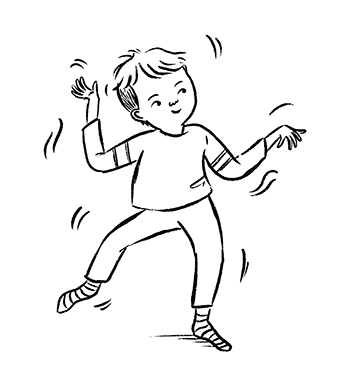Shake it out: why it’s good for children with disability, autism or other additional needs
Shake it out involves shaking, jiggling and wiggling different parts of your body, either one at a time or altogether. Children can do it alone or with other people.
Shake it out gets children with disability, autism or other additional needs moving.
Shake it out can be good for children at stressful times. This is because it can help children release energy and tension. Children might feel calmer after doing this activity. This can be particularly good for children who feel overstimulated or overwhelmed.

What you need for a shake it out activity
All your child needs for shake it out is their body!
How to do a shake it out activity
To begin with, you and your child can shake it out together. Here’s how to get started:
- Sit comfortably or stand with feet slightly apart, knees slightly bent and weight balanced.
- Start with the fingers. Shake, jiggle or wiggle fingers as you count to 5. Then stop.
- Shake, jiggle or wiggle each body part, one at a time – arms, head, shoulders, chest and tummy, bottom, legs and feet.
- Shake everything altogether for 10 seconds and then stop for 5 seconds. Talk with your child about how your bodies feel.
- Shake everything altogether for 20 seconds and then stop for 5 seconds.
Ideas and options
- If your child is enjoying the activity and feels good, gradually increase the shake time – up to 1 minute is OK.
- See whether you and your child can shake different parts of the body at the same time. Try shaking your head and fingers, or your right foot and shoulders.
- Shake and dance to music. You could freeze when the music stops.
Shaking your head can affect your balance. Make sure your child is sitting or standing safely and shakes their head gently at first. If they feel OK, they can increase the shake a little more.
How to adapt a shake it out activity to suit children with diverse abilities
Children with restricted mobility or difficulty with balance might need to sit down to shake. They could also shake with another person. For example, they could hold hands with someone who’s shaking so that they shake their hands with the other person.
For children with autism or learning difficulties, you might need to break the instructions into smaller steps or count out loud.
Shy or anxious children might prefer to begin by watching others and gradually find the confidence to move themselves. When they do join in, try not to watch them as they shake.
For children with sensory processing difficulties or a lot of energy, try increasing the shake time or using music to encourage more full body shaking.
Looking for more play and learning ideas for your child? You might like to explore our other activity guides. Some of these have been created for typically developing children, but they can all be adapted to suit children with diverse strengths and abilities.